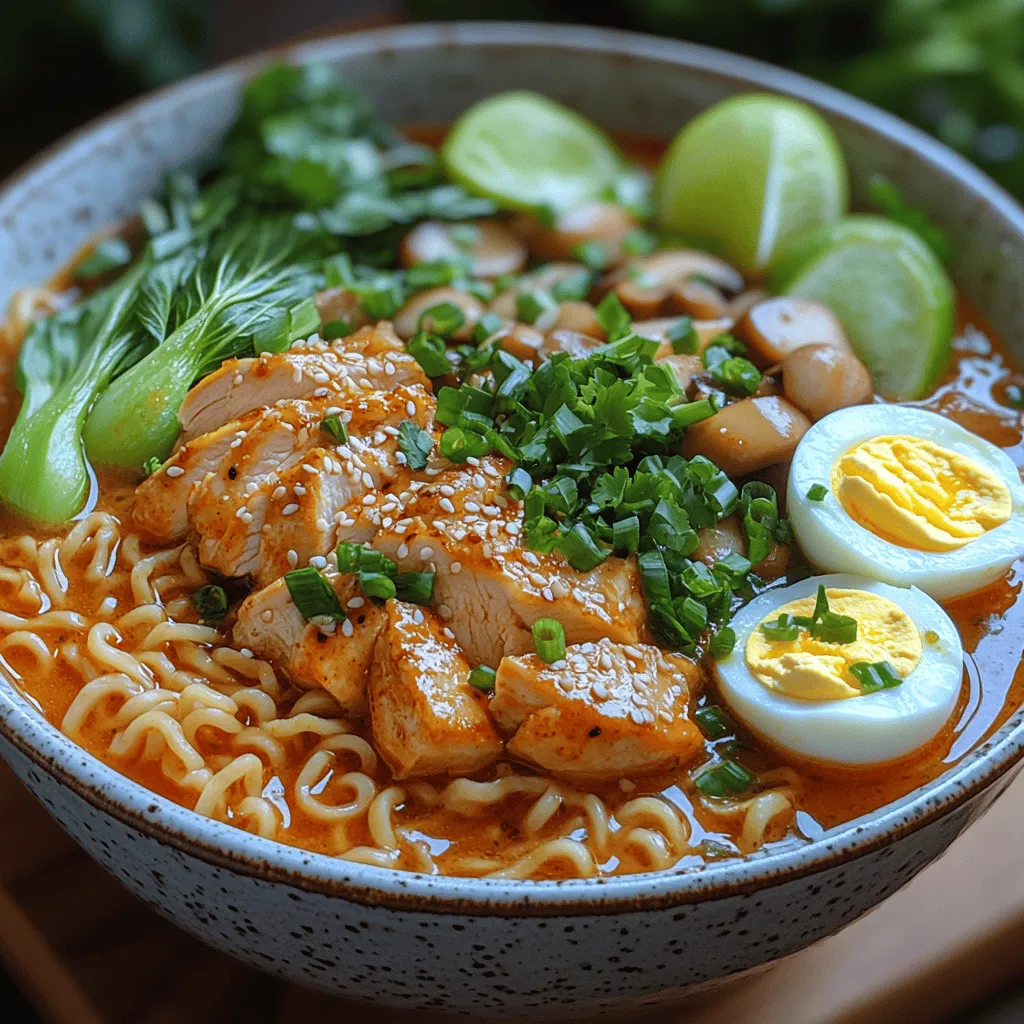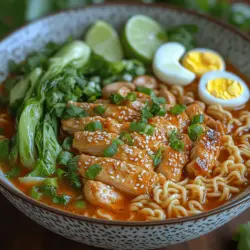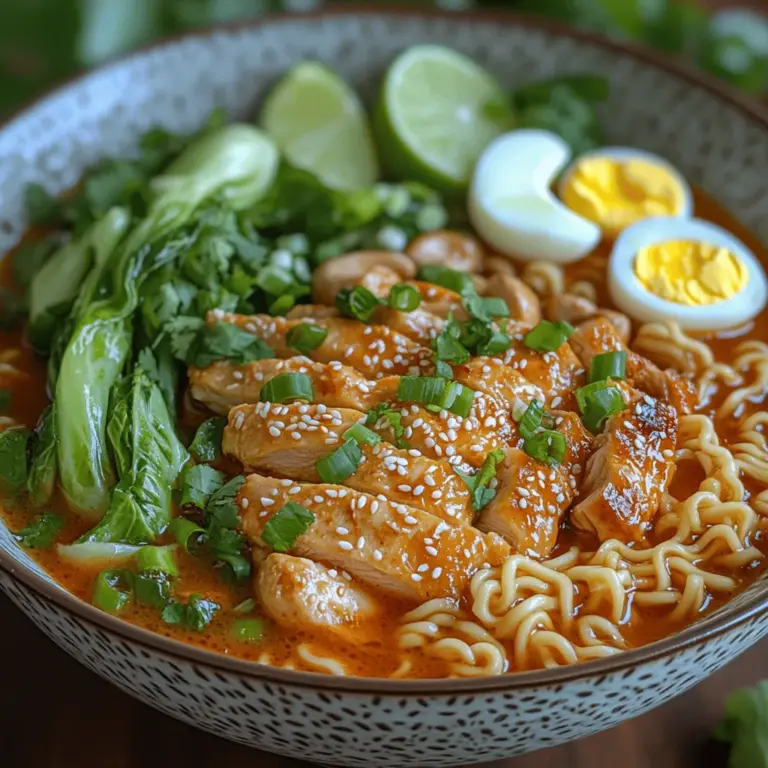Introduction
Ramen is not just a dish; it is an experience that brings together the rich traditions of Asian cuisine. Originating from Japan, ramen has evolved into a beloved meal across the globe, celebrated for its comforting qualities and diverse flavors. Whether enjoyed in a cozy restaurant or prepared at home, ramen has a unique ability to warm the soul while tantalizing the taste buds. Among the myriad of ramen variations, the Spicy Asian Chicken Ramen Noodle Bowl stands out as a vibrant and hearty option that combines the perfect balance of protein, fresh vegetables, and a rich, flavorful broth.
This recipe for Spicy Asian Chicken Ramen Noodle Bowl is not only a feast for the senses but also a nutritious choice for any meal. With tender chicken, an array of colorful vegetables, and a spicy kick, it delivers a satisfying blend of textures and flavors. The heart of this dish lies in its rich broth, which serves as the foundation for the ramen noodles and toppings. This bowl is perfect for those seeking comfort food that is both hearty and healthful, making it an ideal choice for busy weeknights or leisurely weekend meals.
Understanding Ramen Noodles
Ramen noodles are a versatile ingredient that can be adapted to countless culinary creations, transcending borders and cultures. Traditionally made from wheat flour, salt, water, and an alkaline mineral water called kansui, these noodles have a unique texture that holds up well in soups and stir-fries. Their chewy, slightly springy quality sets them apart from other noodle types, making them a favorite among noodle enthusiasts.
Types of Ramen Noodles
In the world of ramen, there are several types of noodles, each with its own characteristics and uses:
1. Fresh Ramen Noodles: Often found in Asian grocery stores, fresh ramen noodles are the most authentic option. They have a soft texture and cook quickly, making them ideal for dishes where the noodles need to absorb the broth’s flavors.
2. Instant Ramen Noodles: A convenient option for quick meals, instant ramen is pre-cooked and dehydrated. While they may lack the depth of flavor found in fresh noodles, they are often fortified with nutrients.
3. Dried Ramen Noodles: These are similar to fresh noodles but have a longer shelf life. They require boiling before use, allowing them to rehydrate and take on a delightful texture.
4. Gluten-Free Ramen Noodles: For those with dietary restrictions, gluten-free options made from rice or buckwheat are now available, ensuring that everyone can enjoy a delicious bowl of ramen.
Ramen noodles are not just a filling component; they also offer nutritional benefits. They provide carbohydrates that fuel the body, and when combined with vegetables and protein, they create a well-rounded meal. By incorporating ramen noodles into your diet, you can enjoy a versatile ingredient that adapts beautifully to various cooking styles and flavor profiles.
The Richness of Broth in Asian Cuisine
In Asian cooking, especially in ramen dishes, the broth is the soul of the meal. A well-crafted broth serves as the backbone for the flavors that develop as the ingredients meld together. It is the starting point that enhances the entire dish, creating a harmonious balance between the noodles, proteins, and vegetables.
Key Ingredients for Flavorful Broth
To achieve a rich and flavorful broth, several key ingredients are essential:
– Chicken Broth: The base of our Spicy Asian Chicken Ramen Noodle Bowl, chicken broth adds a deep, savory flavor that complements the other ingredients. Homemade broth can elevate the dish, as it allows for the infusion of fresh herbs and spices.
– Aromatics: Ingredients like garlic, ginger, and onions are integral to building layers of flavor. They infuse the broth with warmth and depth, enhancing the overall experience.
– Soy Sauce and Mirin: These condiments add a salty and slightly sweet profile to the broth, enriching its complexity.
– Spices: For those seeking a spicy twist, ingredients like sriracha or chili paste can be added to the broth, ensuring that the dish has a kick that lingers on the palate.
While store-bought broth can save time, nothing compares to the depth of flavor achieved through homemade preparation. Taking the time to simmer bones or use leftover chicken carcasses can yield a richer, more nutritious base, setting your ramen apart from others.
Ingredients Breakdown
Now that we understand the significance of ramen noodles and broth in creating a delicious dish, let’s take a closer look at the ingredients required for our Spicy Asian Chicken Ramen Noodle Bowl. Each component plays a vital role in delivering flavor, nutrition, and texture.
Chicken Breasts
As the primary source of protein in this recipe, chicken breasts are lean and versatile. They provide essential nutrients while also absorbing the flavors of the broth. When cooked correctly, chicken breasts remain moist and tender, enhancing the overall enjoyment of the dish.
Chicken Broth
The foundation of our ramen, chicken broth, brings depth and richness to the soup. Homemade broth, simmered with aromatics and spices, elevates the flavor profile, but store-bought options work well in a pinch. Look for low-sodium varieties to control salt levels in your dish.
Ramen Noodles
The star of the bowl, ramen noodles are what make this dish a true ramen experience. Their unique texture and ability to soak up the broth make them indispensable. Depending on your preference, feel free to experiment with different types of noodles to find the one that best suits your taste.
Aromatics: Vegetable Oil, Garlic, and Ginger
Vegetable oil is used to sauté the aromatics, ensuring they release their flavors before the broth is added. Garlic and ginger are key players in Asian cuisine, known for their aromatic qualities. They add warmth and complexity to the dish, enhancing the overall flavor.
Essential Condiments: Soy Sauce, Sesame Oil, and Sriracha
Soy sauce is a staple in Asian cooking, contributing saltiness and depth to the broth. Sesame oil adds a nutty flavor, while sriracha provides the spicy kick that defines our ramen. Adjust the amounts according to your spice tolerance to create the perfect bowl for your palate.
Nutritional Vegetables: Bok Choy, Mushrooms, and Green Onions
Fresh vegetables not only add color and texture to the dish but also provide essential vitamins and minerals. Bok choy is a nutrient-dense leafy green that complements the chicken and noodles beautifully. Mushrooms bring an earthy flavor, while green onions add a fresh, crisp finish.
Optional Toppings: Soft-Boiled Eggs, Sesame Seeds, Cilantro, and Lime
Toppings can elevate your ramen experience. A soft-boiled egg adds creaminess and richness, while sesame seeds offer a delightful crunch. Fresh cilantro introduces a burst of flavor, and a squeeze of lime brightens the dish, balancing the richness of the broth.
As we dive deeper into the recipe, you’ll discover how to combine these ingredients into a cohesive, flavorful dish that embodies the essence of a Spicy Asian Chicken Ramen Noodle Bowl. Each step is designed to maximize flavor while ensuring that the meal remains nutritious and satisfying. Stay tuned for the detailed instructions that will guide you through the preparation of this delightful ramen bowl!

Step-by-Step Preparation Guide
Creating a Spicy Asian Chicken Ramen Noodle Bowl is a delightful culinary journey that combines vibrant flavors and textures. Follow these detailed preparation steps closely to ensure a delicious outcome.
Preparing the Chicken
1. Choose the Right Chicken: Start with boneless, skinless chicken breasts for a lean protein option. You can also use thighs for a richer flavor and juicier texture.
2. Marinate the Chicken: To infuse the chicken with flavor, prepare a marinade using soy sauce, sesame oil, garlic, and a hint of chili paste. Let the chicken marinate for at least 30 minutes—this not only enhances flavor but also tenderizes the meat.
3. Cooking the Chicken:
– Heat a tablespoon of oil in a skillet over medium-high heat. Once hot, add the marinated chicken.
– Cook for 6-8 minutes on each side until the chicken is cooked through and has a nice golden-brown crust. The internal temperature should reach 165°F (74°C).
– Remove the chicken from the skillet and let it rest for a few minutes before slicing it thinly. This resting period allows the juices to redistribute, ensuring moist chicken.
Creating the Broth
1. Sauté Aromatics: Start by heating a tablespoon of vegetable oil in a large pot over medium heat. Add chopped garlic, grated ginger, and sliced green onions. Sauté for about 2-3 minutes until fragrant, being careful not to burn the garlic.
2. Building Flavor: To the sautéed aromatics, add chicken broth (preferably low-sodium), soy sauce, and a tablespoon of miso paste for depth. If you enjoy heat, incorporate sriracha or chili oil at this stage.
3. Simmer the Broth: Allow the broth to come to a gentle boil and then reduce the heat to low. Let it simmer for 15-20 minutes to meld the flavors. Taste and adjust seasoning, adding salt or more soy sauce if necessary.
Cooking Vegetables
1. Select Fresh Vegetables: Choose a mix of colorful vegetables such as bok choy, bell peppers, and carrots. These not only add nutrients but also enhance the visual appeal of the dish.
2. Cooking Timing: Add the vegetables to the simmering broth about 5-7 minutes before serving. This ensures they retain their vibrant color and crisp-tender texture. If using leafy greens like bok choy, add them last, as they cook quickly.
Cooking Noodles
1. Choosing Ramen Noodles: Opt for fresh ramen noodles if available, as they have a better texture compared to instant noodles. If using instant noodles, discard the seasoning packet for a healthier option.
2. Cooking the Noodles: Bring a separate pot of water to a boil. Cook the noodles according to the package instructions, usually 3-4 minutes for fresh noodles. Drain the noodles and rinse them under cold water to stop the cooking process and prevent sticking.
Combining Ingredients
1. Assemble the Bowl: In individual serving bowls, place a portion of cooked noodles at the bottom. Ladle the hot broth and vegetables over the noodles.
2. Add Chicken: Top each bowl with the sliced chicken, ensuring an even distribution among servings.
3. Final Touches: For the perfect noodle-broth ratio, adjust the amount of broth based on personal preference. Some may prefer a soupier bowl, while others might enjoy a heartier portion of noodles.
Serving Suggestions and Presentation
1. Garnishing the Dish: Elevate your Spicy Asian Chicken Ramen with fresh garnishes. Sprinkle chopped cilantro or basil on top, add a squeeze of lime for brightness, and finish with toasted sesame seeds for added crunch.
2. Serving Styles: You can serve the ramen noodle bowl in individual bowls to allow guests to customize their servings or arrange it family-style on a large platter for a communal dining experience.
3. Pairing Suggestions: Complement your ramen with beverages such as green tea or a light Asian beer. For side dishes, consider serving edamame, pickled vegetables, or a simple cucumber salad to round out the meal.
Nutritional Information
This Spicy Asian Chicken Ramen Noodle Bowl not only satisfies the palate but also provides a nutritious meal. Here’s a brief overview of its nutritional benefits:
– Calories: Approximately 450-600 calories per serving, depending on the amount of noodles and chicken used.
– Protein: Each serving provides around 30-40 grams of protein, thanks to the chicken and broth.
– Fats: Contains healthy fats from sesame oil and chicken, contributing to a balanced diet.
– Vitamins and Minerals: The variety of vegetables adds essential vitamins (A, C, K) and minerals (potassium, magnesium), making this a well-rounded dish.
Dietary Accommodations
For those with dietary restrictions:
– Gluten-Free Options: Use gluten-free ramen noodles or substitute with rice noodles.
– Vegetarian Substitutes: Replace chicken with tofu, tempeh, or seitan for a plant-based protein option. Adjust the broth by using vegetable stock and incorporating mushrooms for umami flavor.
Exploring Variations of the Recipe
1. Customizing the Dish: Feel free to make this recipe your own by substituting proteins. Shrimp, beef, or even plant-based proteins can work well. Experiment with different marinades and cooking techniques to discover new flavor profiles.
2. Seasonal Vegetables: Incorporate seasonal vegetables like zucchini, snap peas, or mushrooms based on availability. This not only enhances the dish’s appeal but also takes advantage of fresh produce.
3. International Variations: Explore the vast world of ramen by adapting this recipe to include elements from different cuisines. For instance, a Thai-inspired version could include coconut milk and lemongrass, while a Korean twist might feature kimchi and gochujang.
Conclusion
The Spicy Asian Chicken Ramen Noodle Bowl is a hearty, flavorful, and nutritious meal perfect for any occasion. Its ease of preparation makes it an ideal choice for both busy weeknights and special gatherings with family and friends. The ability to customize the dish according to personal preferences or seasonal ingredients adds to its versatility, ensuring you can enjoy this comforting bowl of goodness time and again.
Embrace the rich flavors and comforting warmth of this ramen dish, and don’t hesitate to experiment with different ingredients and variations to make it uniquely yours. Whether you’re a seasoned chef or a beginner in the kitchen, this recipe promises satisfaction and delight with every slurp.


